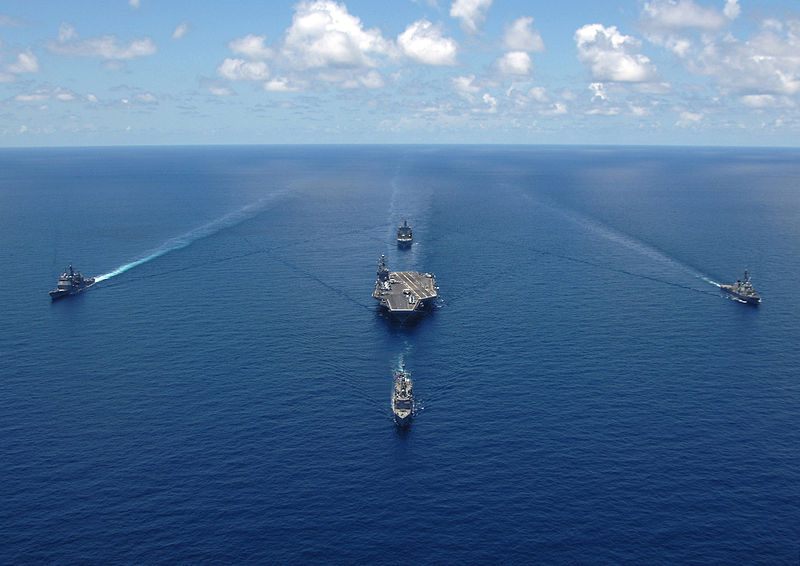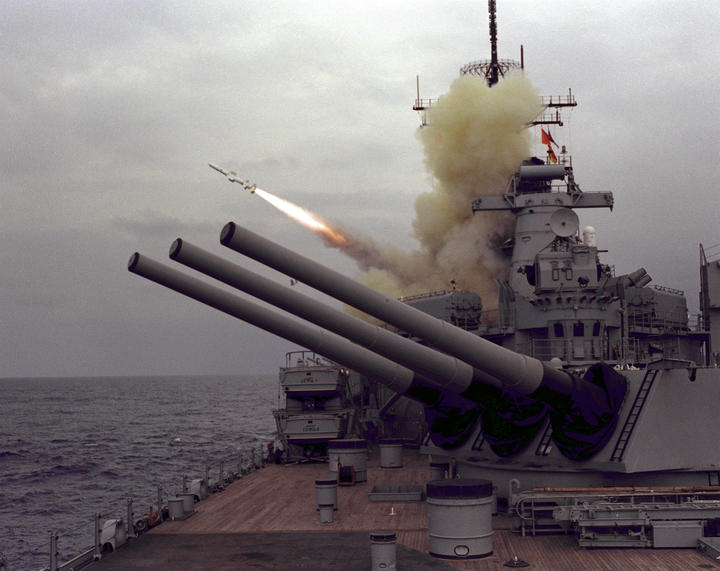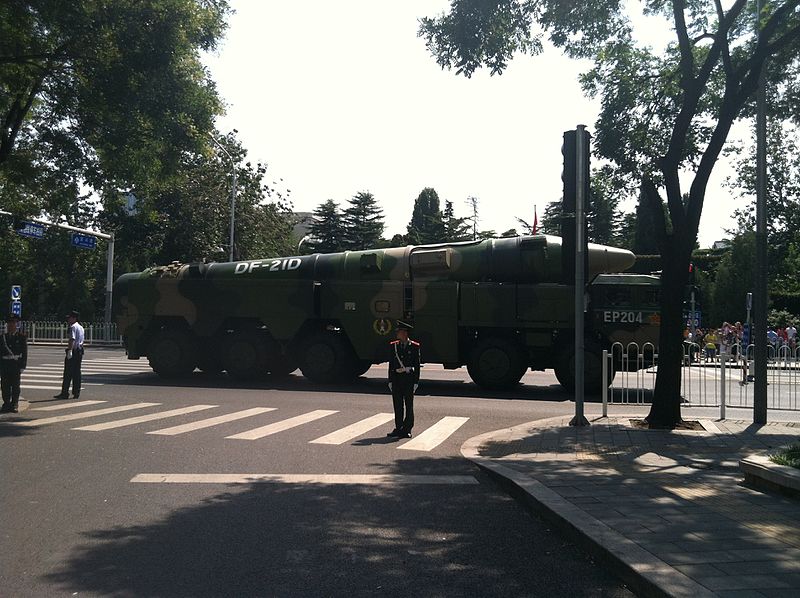Claims that US carriers are very vulnerable to missile attack, and will be sunk immediately in any upcoming war, are quite common. They’re also wrong. The carriers are surprisingly survivable, and the prowess of missiles is usually grossly exaggerated.

USS Nimitz, USS Ronald Reagan and USS Theodore Roosevelt operating together, November 2017
The first line of defense is the fact that the sea is very big[Citation Needed] and ships are small and mobile. Obviously, improved radar and modern navigational systems have made it easier to find and track ships at sea since WWII. Clouds and darkness are no longer serious obstacles, and it’s harder (though not impossible) to mess up your navigation. But there are still problems. A typical radar system will tell you that there is something there, but it won’t tell you what it is. You can make guesses based on where contacts are, but a smart opponent will do all he can to frustrate this. Carrier groups, for instance, never operate in the “bullseye” formation made famous in photos, and often do their best to look like merchant traffic.1

The George Washington Battle Group demonstrating the bullseye formation
The preferred way to solve the identification problem is electronic signal measures (ESM). At the most basic, if there is a radar that is only installed on carriers, and you detect it coming from a ship, then you know it’s a carrier. On a more sophisticated level, most military radars are essentially hand-built, and it is possible to take a ‘fingerprint’ and identify a specific radar remotely. The US, Russia, and China all have sea-surveillance ESM satellites. However, these can be defeated by emissions control, or EMCON.2 While this obviously limits a ship’s capabilities, satellite communications allow ships to avoid most of the disadvantages of EMCON. A satellite can transmit to the surface over a broad area, and a ship can send a tight beam back to the satellite, which is very difficult to intercept. The ship can rely on data from remote sensors (including ESM and IR satellites) to learn of an incoming attack, and only break EMCON after it thinks it has been located.

A long-duration exposure showing a pair of US Naval Ocean Surveillance Satellites
But what about other alternatives? Optical cameras don’t require cooperation from the target, but are stymied by clouds and darkness. IR cameras can't see through the atmosphere to sea level very well. Modern Synthetic Aperture Radar (SAR) platforms like TerraSAR-X/TanDEM-X are quite capable of identifying ships from space. However, they can only see a limited swath of the ocean, particularly in the higher-resolution modes that are required to get firm identification. The combined TerraSAR-X/TanDEM-X cost approximately $400 million. Jane’s says that it can image 90% of Earth’s surface within 2 days, although there are several different resolution modes and I don't know exactly how this was calculated.3 The X-band radar used is badly affected by rain,4 and the US used to hide ships from Soviet radar satellites in bad weather. I’m not sure how effective electronic warfare is against this kind of system, and sources differ on the matter. That said, this is definitely the greatest threat to the free movement of surface ships, but even then, it's only really something the great powers can do, although they can of course pass data to others, as Russia has done to the Houthis.

TerraSAR-X and TanDEM-X in formation
But what about non-space-based options? Can’t we just send out planes or drones to look for the carriers?
The obvious problem we come to again is emissions. A radar can usually be detected at least twice as far away as it can detect anything. The obvious solution for the carrier is to use some form of low-power low probability of intercept (LPI) radio to vector fighters out to kill the snooper, or even simply brief them on deck and send them out under full EMCON. The E-2 Hawkeye has a very good ESM system, and with tankers and cleverness, could manage to at the very least significantly mitigate the ‘flaming datum’ problem. Optical surveillance, besides being flummoxed by clouds, has a very limited range compared to radar, and is best used for identifying targets found by radar. The obvious suggestion is drones, but drones have issues of their own. A search plane could be sent out under EMCON with orders to only report back if they find something. This isn’t really viable for drones, which can then be shot down on the basis of their transmissions.5 Also, drones of the size necessary for effective sea surveillance are large and relatively expensive.

An E-2D Hawkeye
But eventually, the carrier’s luck will run out, and the bad guys will locate them, and they’ll die, right?
Not so fast. A location, particularly one that is targeting-grade, is inherently perishable, and if your opponent knows you’ve got it, then it’s going to spoil even more quickly. Essentially, you have to get your weapons near the target before the area where the target can be gets bigger than the area the weapons can search, and then make sure that those weapons lock on to the right target. This is true regardless of the nature of the weapons, although different weapons have very different parameters for search and lock-on. One example would be an air strike. Spending a lot of time searching for the carrier is a good way to get killed by defending fighters, but the attacking aircraft can still compensate for some degree of imprecision in the fix, and make sure the target they're going after is what they want to hit instead of something else that happened to be nearby.

An F-14 intercepting a Tu-95 Bear
A missile is much less capable of such compensation, and this has been a long-term problem with anti-ship missiles. The US has stopped installing Harpoon missiles (range of ~70 nm) on destroyers and removed the submarine-launched version from service for decades out of fear of hitting the wrong target. The original Tomahawk Anti-Ship Missile, which had an effective range of over 200 nm, was going to solve this problem by using ESM, looking for the radars of a hostile ship. However, this was problematic, and in exercises, the hit rate was around 25%. Some Soviet missiles had datalinks to allow updates after launch, but these required a platform within sensor range of the target, while modern missiles like NSM use sophisticated image recognition to hopefully hit the right target even well over the horizon.

Iowa launching a Harpoon
Ballistic missiles have an even bigger problem. Unlike a cruise missile, they cannot wait and search for a target. The first ASBM, the Soviet SS-NX-13, was designed to home in on radar emissions, but never entered service, as it would have displaced ballistic missiles on submarines, the numbers of which were limited by treaty. The guidance mechanism of the DF-21D is not known, but there are only a few options. Optical guidance is right out, as it doesn’t work at night or in bad weather. IR does work at night, but is still vulnerable to bad weather, a common problem at sea. Radar might work, but is vulnerable to countermeasures and there are limits on what can be done with a platform the size of a missile warhead, particularly in terms of non-cooperative identification. In plain English, the missile can’t tell the carrier from a destroyer with a blip enhancer or a merchantman. Home-on-radar is an option, but can be foiled by not using radar or using a different kind of radar than the missile is expecting.6

A DF-21D missile
All of this gives a very limited window for the attacker to take a targeting-grade sighting and get the data to the weapons. This is usually ignored in popular articles, but it’s very important. Every minute, a carrier at full speed gets another ~900 m away from the initial fix. The internet makes instant, reliable communication seem easy, but the list of outages and failures due to various bad actors should be a reminder that this kind of communication is difficult and vulnerable to disruption. Throw in an active and very hostile power, and the network is likely to be seriously disrupted at best, and brought down at worst. China might have made the investment in targeting platforms and communications to be able to effectively target something like the DF-21D, although we can’t be sure how well their efforts will work until it’s tried for real. Enemyistan almost certainly hasn’t. Early US attempts at this kind of targeting often saw data delayed by an hour or more, and they were not facing the full array of countermeasures that a major power can bring to bear. If the delay is too great, then there’s nothing in the missile’s field of view when it shows up, and it either plunges into the sea or takes out something it thinks is a carrier, but turns out to be a Danish container ship.

A Danish container ship
None of this should be taken to mean that the US carriers are completely safe from detection. There are ways to find ships at sea, but they are expensive and difficult, and their effectiveness can’t be absolutely certain. China appears to be working hard to deal with this problem, and it's very possible that they can locate the carriers reasonably effectively, but they have dozens of satellites and large, expensive over-the-horizon radar systems, which any other power is unlikely to be able to match. That said, these problems are an important part of the equation, and someone who ignores them when discussing the matter should not be taken seriously.
The difficulty of finding the carrier is only the first line of defense. Next time, I'll discuss the active defenses a carrier can mount to an attack.
1 See this article for a more detailed explanation of how this is done. ⇑
2 Basically, you just don't use the radio or radar. This is common practice in western navies. ⇑
3 The best data I have suggests that you can get data between 20 and 45 degrees off-nadir, which translates into the ability to look at areas between 170 and 460 km off the ground track, on one side. This is probably enough to fix and identify a carrier that has already been roughly located, although the finer modes have swath widths of only 10-30 km. ⇑
4 For some reason, Airbus fails to mention this in their marketing literature ⇑
5 Directional satcom works much better on ships than on airplanes. ⇑
6 The SPY-1 radar of Aegis has special modes to fool radar-homing missiles. ⇑

Comments
Out of curiosity, how much easier does finding a carrier in war time get if you have a spy among the crew? Carrier crews are big enough to have drug-dealers and prostitution rings, so it is not that unlikely.
I'm not sure. You could definitely give someone a homing beacon, and they could almost certainly smuggle it onboard, but I'm sure that the Navy has thought of this and probably has some ESM equipment dedicated to picking up any signal. If nothing else, the Hawkeye flies over occasionally and listens. Also, there's the issue that the spy would know they're on a major target, which isn't good for morale.
You could
Would it even need to be a ship-to-ship signal? I don't know much about technology, but I would think that something that periodically emailed its GPS coordinates to plan@gmail.com wouldn't be too large or expensive.
There's no internet connection in the open ocean apart from via satellite. I assume ships have some way to officially connect to the internet via Iridium or DoD comsats but they'd never let random sailors use it to send unvetted messages during wartime. You could try to smuggle your own satphone on board but I hope the SIGINT people would notice if you tried to use it. Also they don't work so well when you're inside a big metal box so you'd have to transmit from the deck.
I wouldn't totally rule out smuggling a beacon aboard, but I think the risks of it being discovered are too high for them to count on this. Email is definitely out, as they'll be monitoring that and locking it down in wartime. And I'm very sure that the USN's security people are already several levels deeper on this than we can get.
A hidden beacon smuggled aboard is a movie-plot level threat. I laugh in its face "HAHAHAHAHAHA"
Let me tell you of my experiences using FRS radios aboard a cruise ship. They had maybe 50 yards range below decks, and the batteries (expensive lithium cells) barely lasted the cruise (and were mostly in standby during the period). (Which is why we ended up buying the internet package last time - it meant we could use IMs and VoIP to communicate.)
A beacon hidden in the bilges is worthless, and even one up on deck needs a honking big power pack to be worthwhile. Physics hates this plan.
And then the CVBG's emissions checks when they go to EMCON detect it anyway.
Even if your beacon is cleverly designed to remain inert until the opportune moment, which is harder than it might seem, it's not going to work from inside a big metal box. It's going to need to have an antenna with a view of the sky. And if it's anywhere on the flight or hangar deck, it's going to be fairly quickly spotted on a FOD walk.
There might be a few places on the superstructure that don't get that treatment, but they're going to be small areas with restricted crew access and the crewmen with access will have a pretty good idea of what does or doesn't belong in their workspace.
As John notes, something that could be visible from space high up on the island that could respond to on-demand pinging from satellites is doable. Wouldn't even be hard to do, really. But (as John also notes!) there's a limited number of people who would have access to do it, and they'd be smart enough to know why it's being done. There's probably also EMI issues that are going to be hard to solve.
That's actually a really good point. China successfully figures out how to build and conceal a beacon so that nobody notices, tries to turn it on, and discovers that it was fried the first time the air-search radar was switched on.
(This isn't a joke. Naval aircraft have much higher standards for operating near radars and the like than their land-based counterparts because the radar is right next to them instead of sitting a ways away. This has caused problems when they've tried to operate Army helicopters from carriers.)
An object that you hide on an enemy vessel to compromise it at some point in the future? That just sounds like a limpet mine with extra steps.
USS FIRSTSHIP once fried a bunch of electronics on a civilian ship by keeping SPY on too high a power at too close a range.
Via the Soviet Battleships Pt 3 Comments and commentor muddywaters, apparently some of the antiship missiles the Iraqis were using in the first Gulf War:
"[W]were also susceptible to HERO (hazard of electromagnetic radiation to ordnance) meaning if stored near a powerful radar they might spontaneously explode."
https://wwiiafterwwii.wordpress.com/2019/07/21/missile-attack-on-battleship-uss-missouri/
Err, Iran-Iraq War (And earlier), not the GW.